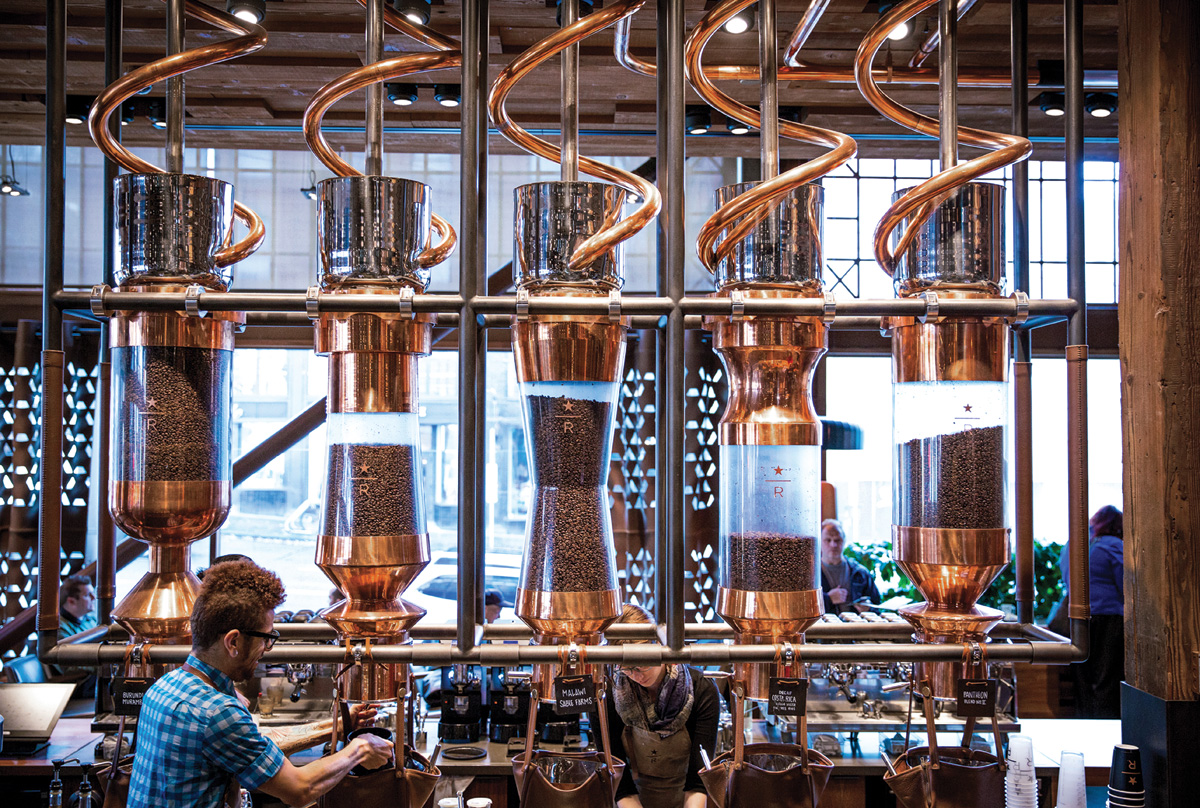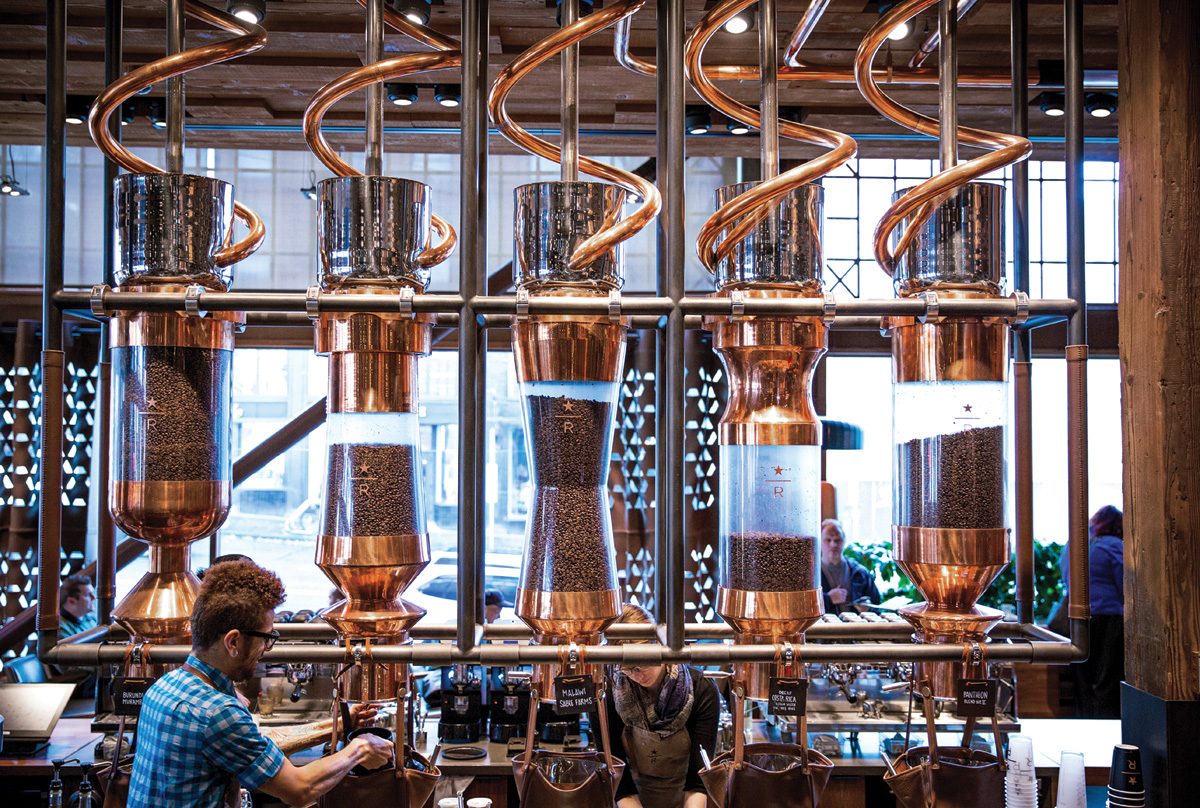
The Starbucks Corporation could not be a more perfect example of the proverb, “A rolling stone gathers no moss.” Rampant global expansion, along with diversification and risk taking in the areas of product testing, employee relations, technology, and sustainability, have all propelled the coffee mega-chain into lifestyle-brand status.
But what happens when sales are up and the heart of your business—customer traffic to your store—is down? Starbucks’ 2018 first-quarter fiscal earnings report showed net revenues of $6.1 billion but also revealed a company that struggled to attract holiday shoppers (holiday traffic was down and limited-time holiday beverages and merchandise underperformed).
President and CEO Kevin Johnson, who took over for Howard Schultz early in 2017, says the decline in transaction comps is fixable. “We have a clear understanding of the issue and are accountable to fix it just as we did with throughput at peak,” he said during the first-quarter earnings call. “The strength of our core customers, the performance of our business through the morning and lunch daypart, and upcoming food, beverage, and digital innovation, gives us confidence that we will be successful in doing so.”
But how?
Perhaps some answer can be found in Starbucks’ official mission statement, which it rolled out in 2008: “To inspire and nurture the human spirit—one person, one cup, and one neighborhood at a time.” Here are five ways Starbucks plans to infuse that human connection into its future strategy.
Experience
Former president and CEO—and now executive chairman—Howard Schultz describes the “Starbucks Experience” in his book Onward as “our purpose and reason for being.” But in 2007, as the company grew larger, he felt that the experience was somehow fading. Schultz noticed that he didn’t smell the coffee in stores anymore, and customers were complaining about “cookie-cutter” layouts. He made a strategic move to close all 7,100 stores in February 2008 for a three-hour training session. The company took a step back and slowed expansion, improved its coffee making, and reintroduced the sights, smells, and design elements that had once defined the brand.
Now, even though guests in Montana may walk into a different store layout than those in Mississippi, there are common factors that all stores share—a sense of community, comfortable surroundings, and that familiar coffee aroma that follows them home on their sweater.
Store design, or brand localization, is just one of the creative ways Starbucks connects with its customers, integrating local aesthetics into each of its stores. The company’s design studios are strategically located so that designers can better understand their communities. In Times Square, you may discover a theatrical feel inside each store; in the South, designers might pull inspiration from a weathered barn or blues music; and at a store near the beach, colors borrowed from lapping ocean waves may be the latest inspiration.
Howland Blackiston, principal at King-Casey in Westport, Connecticut, has led a variety of Starbucks’ design projects. He says that one of the biggest design decisions Starbucks ever made was adding a drive thru, which was a departure from the company’s “home away from home” vibe.
True to form, Starbucks wanted a revolutionary drive-thru model. The company found ways to bring the interior brand experience to the outdoor lane, experimenting with digital confirmation boards at the drive thru with two-way live video communications that featured a barista making your beverage, Blackiston says. The drive-thru results have been so dramatic (drive-thru stores do 50 percent more business) that a few years ago, Starbucks authorized the largest capital expenditure in its history to add drive thrus to the majority of locations, he adds.
“Starbucks is a stellar example of, ‘What can we do next to dazzle the customer?’” Blackiston says. “Starbucks understands that a great brand experience is all about understanding customer needs, attitudes, and behaviors, and then continually finding innovative ways to meet and surpass those needs. This is not a brand that rests on its laurels.”
Leadership
When Schultz stepped down as CEO last year to become executive chairman, Kevin Johnson, who had been on the board of directors since 2009 and served as president and COO since 2015, assumed the role. Johnson came to Starbucks with 32 years of technology background that he picked up at companies like Microsoft and Juniper Networks.
The leadership pair of Schultz and Johnson has so far been a good complement. With Schultz focusing his time on social initiatives and global retail expansion of new projects such as Starbucks Reserve Roasteries and Starbucks Reserve retail locations, Johnson focuses his time on leading the company’s operations and tech growth.
“Together, we will reaffirm our leadership in all things coffee, enhance the partner experience, and exceed the expectations of our customers and shareholders,” Johnson said when his promotion was announced. “We believe in using our scale for good and having positive social impact in the communities we serve around the world.”
In another boost to the leadership portfolio, Starbucks added three new executives to its board of directors in 2017, hailing from companies such as Walmart, LEGO, and Microsoft. All bring valuable skills to the table in the fields of technology, strategy, and retail that can help propel Starbucks into its next chapter.
Product
It may be hard to believe now, but there was a time when Americans didn’t know what a latte was. Those days are long gone. Innovation is the name of the game, and today, there is more pressure than ever for companies to bring new products to market.
Consumers are especially gravitating toward companies that offer unique LTOs and Instagrammable menu items. With Starbucks Reserve Roasteries serving as laboratories, the company can test and perfect new ideas before rolling them out to stores. Products such as the Cascara Latte and Nitro Cold Brew got their start at the Reserve Roastery in Seattle, and the experiments have already started to pay off.
“In response to strong customer demand, we are accelerating the rollout of Nitro Cold Brew from 1,300 stores currently to 2,300 stores in the U.S. by the end of the year,” Johnson said in the company’s Q1 earnings call. “Nitro also provides the foundation for a broader platform of draft beverages that expand beyond coffee to include alternative milks and tea-based, nitro-infused beverages.”
Starbucks has also nearly doubled its food business since 2013, with new product introductions like the Sous Vide Egg Bites, sandwiches, and a Mercato menu that features grab-and-go salads and sandwiches.
And while new Starbucks retail products continue to funnel into grocery stores nationwide, Starbucks removed the ability to purchase its products online in the fall of 2017, with Schultz explaining to investors last April, “Every retailer that is going to win in this new environment must become an experiential destination. Your product and services, for the most part, cannot be available online and cannot be available on Amazon.”
The decision to eliminate online retailing was just another step toward bringing customers back into the brick-and-mortar stores and returning to the original idea of Starbucks being a third place in consumers’ minds—the first being home, the second being the office, and the third being a place to relax like Starbucks.
Technology
Starbucks may not have an overly “techy” feel when one is sunken into one of its leather chairs and sipping on a macchiato, but Tom Kneubuehl, executive vice president of North America at Preoday, a U.K.-based cloud technology company, says he believes that technology innovation is ingrained into what Starbucks is as a company.
“They’re trailblazers and fearless innovators,” says Kneubuehl, who has been watching the company grow since 2000. “They have a test, learn, and adjust mentality; they embrace change, and they don’t worry about being perfect.”
Starbucks’ history is full of big technological steps forward. In 1998, it was one of the first companies to launch a website; in 2002, it began offering WiFi to its customers, helping to start the transition from quick coffee stop to all-day hangout; and a full decade ago, Starbucks was establishing its social media presence.
Now, while others are setting up mobile payment terminals and struggling to start a loyalty program, Starbucks is seeing 11 percent of its sales from mobile order and pay, and 14.2 million Starbucks Rewards members accounting for 37 percent of U.S. company-operated sales.
Things don’t always go as planned for those who serve as innovators, however. Starbucks’ mobile orders ended up causing a bottleneck that hurt sales. But the company quickly pivoted and tweaked the process to remedy the issue.
“They continue to push forward on multiple fronts on the product side, with mobile order and pay, loyalty, and products that strengthen customer relationships and drive a better customer experience,” Kneubuehl says. “They’re actually broadening the footprint of their stores with technology. If everything was a walk-in order, you’d only be able to sell what people could drive up and wait around to get. But by having mobile pay and drive thru, they can extend that store footprint out for miles.”
Looking toward the future, Starbucks has already become more interesting to millennials with its gamified Starbucks for Life and Bingo promotions, which allow loyalty members to play games and earn points toward free products.
And, following an expanding trend in artificial intelligence, in 2017 a Starbucks Reorder Skill was added to the Amazon Alexa platform and the My Starbucks Barista chatbot debuted, letting users order their favorite coffees using simple voice commands.
Social responsibility
As a company with massive global reach, Starbucks has the power to make an impact on people beyond their morning cup of joe or afternoon Frappuccino. The company’s Vision for 2020 and Beyond includes projects in the areas of coffee sustainability, greener retail, and community engagement.
The brand’s key business driver—coffee—is one that it focuses most of its attention on. In its Coffee and Farmer Equity (c.a.f.e.) Program, Starbucks is making a commitment to purchase 100 percent ethically sourced coffee. Today, it is only 1 percent away from meeting that goal.
These social responsibility efforts are among the best in the industry, according to Sustainalytics, a Toronto-based company that provides environmental, social, and corporate research on publicly listed companies and then packages it into company ratings used by investors.
Lead analyst Joshua Zakkai says Sustainalytics looks at the impact of food companies’ operations and supply chains. “In our overall rating, Starbucks ranks quite well compared to peers in the industry,” he says. “We have them as a leader on environmental issues within owner operations and supply chain combined.”
At Starbucks, employees are referred to as partners and can receive perks such as medical benefits, profit sharing, and tuition assistance in an effort to decrease turnover and bring a more familial feel to the work environment.
Employee programs such as veteran, refugee, and youth hiring initiatives welcome diversity into Starbucks stores, while the CUP (Caring Unites Partners) Fund was set up to help Starbucks’ partners donate to fellow partners who have gone through natural disasters or personal crises.
Beyond helping its partners, a strategic partnership was started with Feeding America in 2016, which allows food to be picked up at closing time instead of during store hours, helping to ensure more food donations. At scale, Starbucks hopes to provide 50 million meal donations annually and divert 60 million pounds of food waste from landfills.
Looking toward the next decade with new leadership, more international locations, fast-moving technologies, and innovative sustainability programs, Starbucks is setting itself up to connect to billions of new consumers—one person, one cup, and one neighborhood at a time.

